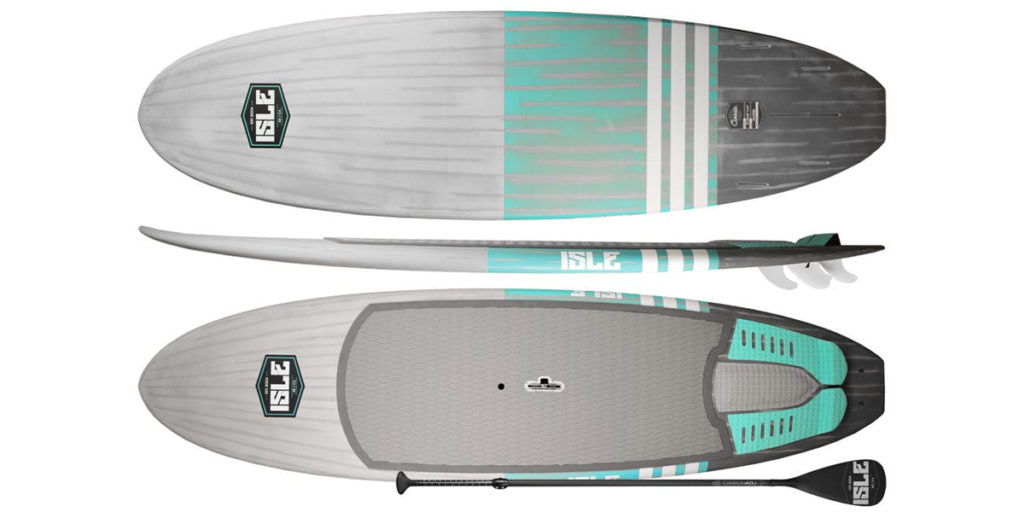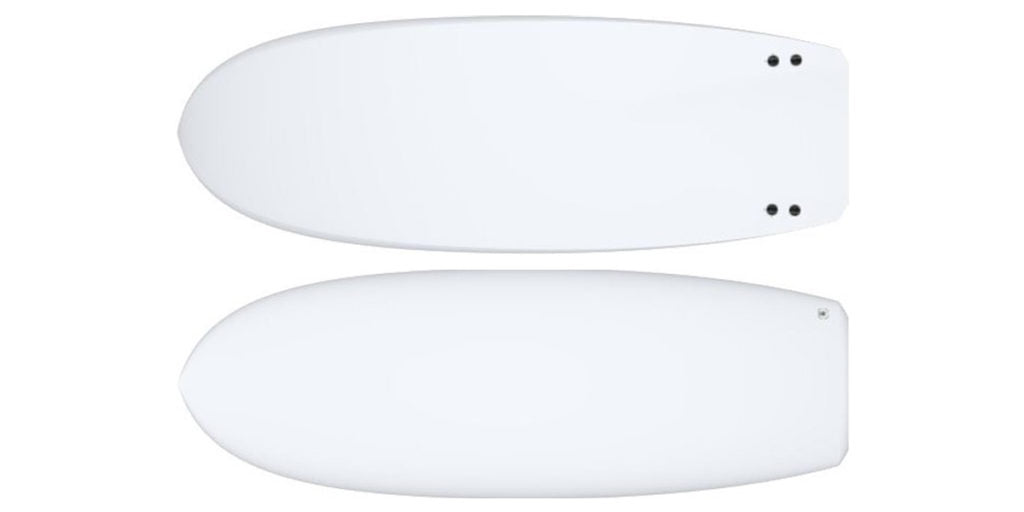



Posted on August 16, 2019 by Jeff Hale
The types of surfboards you ride say a lot about your personality and experience in the water. Veteran surfers know what they love and likely have a large collection (quiver) of boards from which to choose. But it can take years for new surfers to find the perfect surfboard without the right guidance.
Surfboards are designed and built for a wide variety of surf conditions and rider skill levels. The combination of surfboard shapes and design details is infinite, which can make selecting the right type of surfboard difficult. And there’s so much crossover between surfboard designs these days that it's difficult to classify a board by one category. But even among all the different types of surfboards on the market today, there are a number of general guidelines you use with confidence to narrow your search. And if you’re shopping for a new surfboard, it’s helpful to learn about all of the different types of surfboards to make sure you’re getting the best board for your skill level and the waves you intend to ride.

The modern shortboard is the most popular type of surfboard for high-performance surfing in the best conditions around the planet. These boards typically range from 5’4” to 6’4” in length. They feature three fins in what’s called a thruster setup and have a pointed nose to cut through the water efficiently in sharp turns. Because of their smaller size and relative lack of buoyancy, they’re not ideal beginner surfboards. Their lightweight construction makes them particularly susceptible to dings and damage.

A fish surfboard or hybrid surfboard is yet another variation of the standard high-performance shortboard. A fish features much more volume in the board's nose, greatly helping with a surfer’s ability to catch waves. These boards traditionally feature two fins and a relatively flat rocker. These elements help the board glide across the water easily while creating more surface area for added speed. But its hallmark feature is the split tail design that’s reminiscent of a fish’s caudal or tail fin. This tail creates a longer rail for a shorter board, offering surfers enhanced drive and a quick release on turns.
Fish surfboards were incredibly popular in the 1970s but have enjoyed a significant renaissance over the last decade. Fish surfboards are ideal for surfers who want a little help making the most of smaller waves but like the idea of approaching a wave with a classic style that’s similar to riding a longboard.

The funboard is the ideal beginner surfboard. With a typical length of 7’6” and soft top (foam) construction, the funboard has enough buoyancy to keep beginner surfers floating, while still being small enough in shape to learn how to turn effectively. These boards typically feature three fins in what’s known as a thruster setup. They’re the perfect surfboard for learning how to surf, but they’re also fun for experienced surfers to ride in smaller waves or crowded lineups.

The longboard surfboard is an old-school board for cruising with style across gently breaking waves. A classic longboard is typically in the 9-foot range and features a large single fin and a thick wood stringer for added stability. These types of surfboards are incredibly stable in the water, allowing riders to walk to the nose of the board to enjoy the nostalgic feeling of hanging ten in style.

The mini-longboard or “mini-Malibu” bridges the gap between funboards and longboards in design and intended use. They typically range in length from 7’6” to 8’6” and feature an assortment of fin options. The size and buoyancy of the mini longboard make them great for beginners, but they’re particularly fun for advanced surfers who can turn these little cruisers into high-performance machines in a wide variety of conditions.

It’s debatable whether a stand up paddle board can be classified as a surfboard. But the fact remains that many people use their SUP for surfing everything from crumbly small surf break to some of the biggest waves ever ridden. The human body can only paddle so fast, stand up paddle boards give us added benefit of a paddle to increase our speed in the water and keep up with bigger types of waves that would normally pass us by. While stand up paddle boards are most frequently used for recreation and exercise in calm bodies of water, professional watermen like Laird Hamilton have shown the world how fun these boards can be in bigger surf.

A groveler is a specialized shortboard that performs well in the smaller, weaker waves most of us surf on a daily basis. They’re typically 3-4 inches shorter than their standard shortboard counterparts and feature more volume, wider noses and tails, and a much flatter rocker (curve on the bottom of the board) to help surfers maximize their fun on smaller days. Grovelers are perfect for surfers who want the performance of a shortboard but don’t necessarily have a wave that’s big or powerful enough for high-performance surfing.

While the alaia is not the world’s first surfboard design, it is the first surfboard designed to ride the face of the wave. A typical Alaia is 7-12 feet in length, made from wood, and weighs up to 100lbs. These types of surfboards are different from every other board on our list because they don’t incorporate any vertical fins to help steer the board or hold it in the face of a wave. Instead, they rely on the sharp edge of the rail and the skill of the rider to hold their spot on a wave. The lack of vertical fins means these boards have little to no drag, making them incredibly fast down the line. The tradeoff for that speed is their difficulty to maneuver. Controlling a board without fins is next to impossible for anyone but the most skilled surfers.

The mini-Simmons or “planing hull” is a speed machine from the 1950s. Inventor Bob Simmons, a Douglas Aircraft mathematician, took design cues from mid-century naval ships and construction materials from the aerospace industry to revolutionize the way surfboards are built and ridden. These boards are relatively short and wide, and typically feature a very small amount of concave through the center of the board to help move water efficiently through the twin fins. These boards excel in small, weaker waves under the feet of surfers who want something “different” to take to the beach. They’re also very popular surfboards for amateur shapers who are learning the craft.

Guns are for paddling into the biggest and most dangerous waves imaginable. These types of surfboards blend the buoyancy and speed of a longboard to help surfers catch massive waves that would be impossible to paddle into on a smaller board. They’re effectively paddling boards with enough foam to catch monstrous waves and remain stable at blistering speeds, as the rider holds on for dear life. Most big wave guns have four fins in a "quad" setup. Guns typically range in length from 7-10 feet.

The asymmetrical surfboard is a unique take on board design. They cater to the undeniable fact that we approach waves differently depending on which direction we ride. In fact, the way you turn on a surfboard when your toes are facing the wave is inherently different than the way you turn when your heels are facing the wave. Generally speaking, your heel turn is abrupt, while your toe-side turn is smoother and longer. Asymmetrical boards utilize very different design elements on the left and right sides of the board to meet the differing needs of a surfer’s heel and toe turns. Asymmetrical surfboards can come in a wide variety of shapes and lengths, but they’ll always have different outlines -- and even fin placements -- on the left and right sides. This means that goofy- and regular-footed surfers can't ride the same asymmetrical board.

While the standard shortboard from the early 1980s is frequently discussed as the first surfboard design with three fins, it’s actually the bonzer that takes credit as the first iteration of the tri-fin surfboard. Crafted in 1972 by Ventura, California brothers Malcolm and Duncan Campbell, the bonzer was a little too far ahead of its time to rise to popularity in its day – the market just wasn’t ready for deep single-to-double concaves and wild keel-style fin designs. The original bonzers featured a large middle fin with two smaller side fins. However, modern bozners often utilize four keel-style fins. At roughly 19 degrees off vertical, Bonzer side fins are canted out much more than standard thruster fins. When you’re locked into a bottom turn, the angle of the inside fins becomes vertical while the outside fins help to add more thrust or drive.
The Campbell brothers succeeded in building a fast but forgiving board that rolls in and out of turns easily and performs admirably in the pocket. If their design was easier to replicate, the bonzer may have become the dominant types of surfboards of the ‘80s and beyond.

For over 20 years, ISLE's mission has remained the same - to inspire & equip for a life that's Better in Balance™ through adventure on the water.
We are the trusted leaders in inflatable paddle boards, dedicated to innovating and redefining what paddle boards can do.
We proudly partner with 1% for the Planet, donating 1% of our revenue to environmental causes that protect our oceans, rivers, and natural habitats.
Every ISLE product is covered by a n industry-leading 2-year or 5-year warranty again defects in workmanship and materials for your peace of mind.
Orders ship the same or next day, and we offer package protection for added peace of mind.
We offer a 60-day trial period from the date of purchase to make sure you love your new gear.
SIGN UP FOR OUR NEWSLETTER
Sign up for our emails and be the first to know about exclusive deals, limited time offers, and big savings as soon as they drop.
Copyright © 2025 Paddle Boards and Surfboards By ISLE Surf & SUP. All Rights Reserved